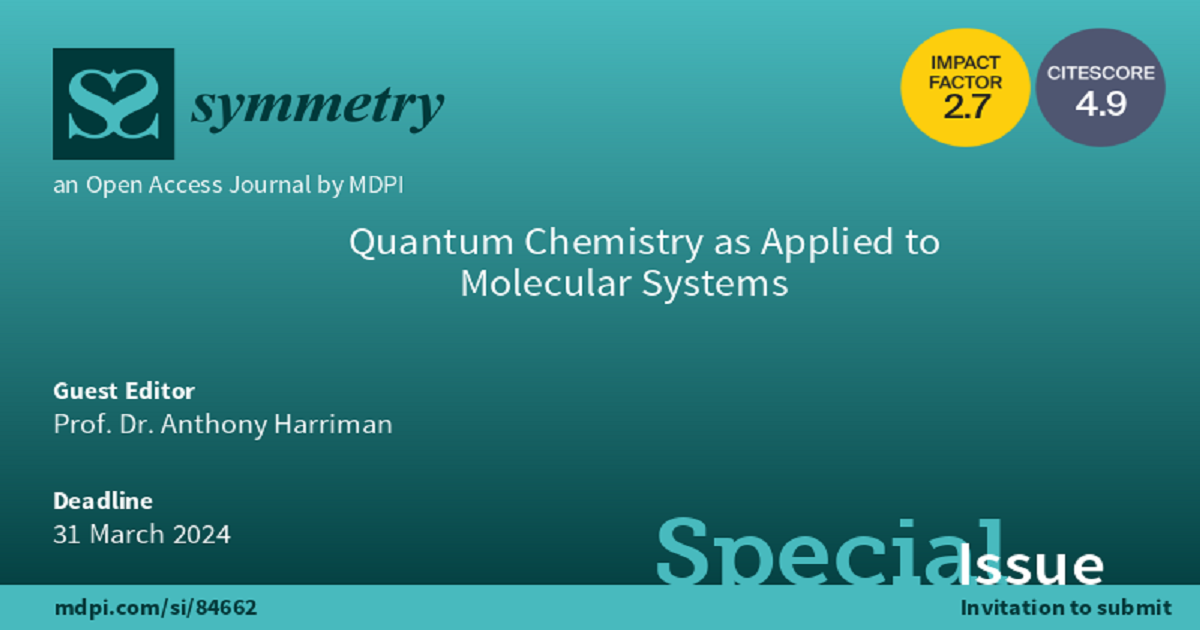Quantum Chemistry as Applied to Molecular Systems
A special issue of Symmetry (ISSN 2073-8994). This special issue belongs to the section "Chemistry: Symmetry/Asymmetry".
Deadline for manuscript submissions: closed (31 March 2024) | Viewed by 8195

Special Issue Editor
Interests: photophysics; optical spectroscopy; dye chemistry; kinetics; energy and electron transfer; physical chemistry
Special Issues, Collections and Topics in MDPI journals
Special Issue Information
Dear Colleagues,
Quantum chemical calculations are an integral part of contemporary chemistry and are used to support experimental work in virtually every part of the discipline. The accuracy of the calculations has improved steadily while the knowledge, tools, and expertise have been passed from specialist to general user. The result has been improved understanding, accelerated discovery, and facilitated optimisation of molecules, molecular materials, and interfaces. This Special Issue seeks to coordinate recent advances in quantum chemical methodology in the general field of molecular science. Emphasis is given to quantum chemical studies of molecular associates, such as dimers, in both ground and excited states and in developing new tools to aid spectroscopic investigations. Both excitonic and vibronic couplings are now addressable by theoretical methods, while the involvement of charge transfer or extended p-conjugation in large organic molecules merits special attention. The study of delocalised organic radicals, such as those derived from cyanine dyes, is necessary for an improved understanding of super-resolution microscopy. Manuscripts covering related topics are welcome.
Prof. Dr. Anthony Harriman
Guest Editor
Manuscript Submission Information
Manuscripts should be submitted online at www.mdpi.com by registering and logging in to this website. Once you are registered, click here to go to the submission form. Manuscripts can be submitted until the deadline. All submissions that pass pre-check are peer-reviewed. Accepted papers will be published continuously in the journal (as soon as accepted) and will be listed together on the special issue website. Research articles, review articles as well as short communications are invited. For planned papers, a title and short abstract (about 100 words) can be sent to the Editorial Office for announcement on this website.
Submitted manuscripts should not have been published previously, nor be under consideration for publication elsewhere (except conference proceedings papers). All manuscripts are thoroughly refereed through a single-blind peer-review process. A guide for authors and other relevant information for submission of manuscripts is available on the Instructions for Authors page. Symmetry is an international peer-reviewed open access monthly journal published by MDPI.
Please visit the Instructions for Authors page before submitting a manuscript. The Article Processing Charge (APC) for publication in this open access journal is 2400 CHF (Swiss Francs). Submitted papers should be well formatted and use good English. Authors may use MDPI's English editing service prior to publication or during author revisions.
Keywords
- Charge transfer
- Excited states
- Push–pull molecules
- Delocalised radicals
- Intersystem crossing
- Quantum confinement in organic molecules
- Spectroscopy
- Circular dichroism
- Molecular aggregates
- Excitonic coupling
- Vibronic coupling
- Excimers
- Quantum coherence
- Circularly polarised luminescence
Benefits of Publishing in a Special Issue
- Ease of navigation: Grouping papers by topic helps scholars navigate broad scope journals more efficiently.
- Greater discoverability: Special Issues support the reach and impact of scientific research. Articles in Special Issues are more discoverable and cited more frequently.
- Expansion of research network: Special Issues facilitate connections among authors, fostering scientific collaborations.
- External promotion: Articles in Special Issues are often promoted through the journal's social media, increasing their visibility.
- e-Book format: Special Issues with more than 10 articles can be published as dedicated e-books, ensuring wide and rapid dissemination.
Further information on MDPI's Special Issue polices can be found here.





